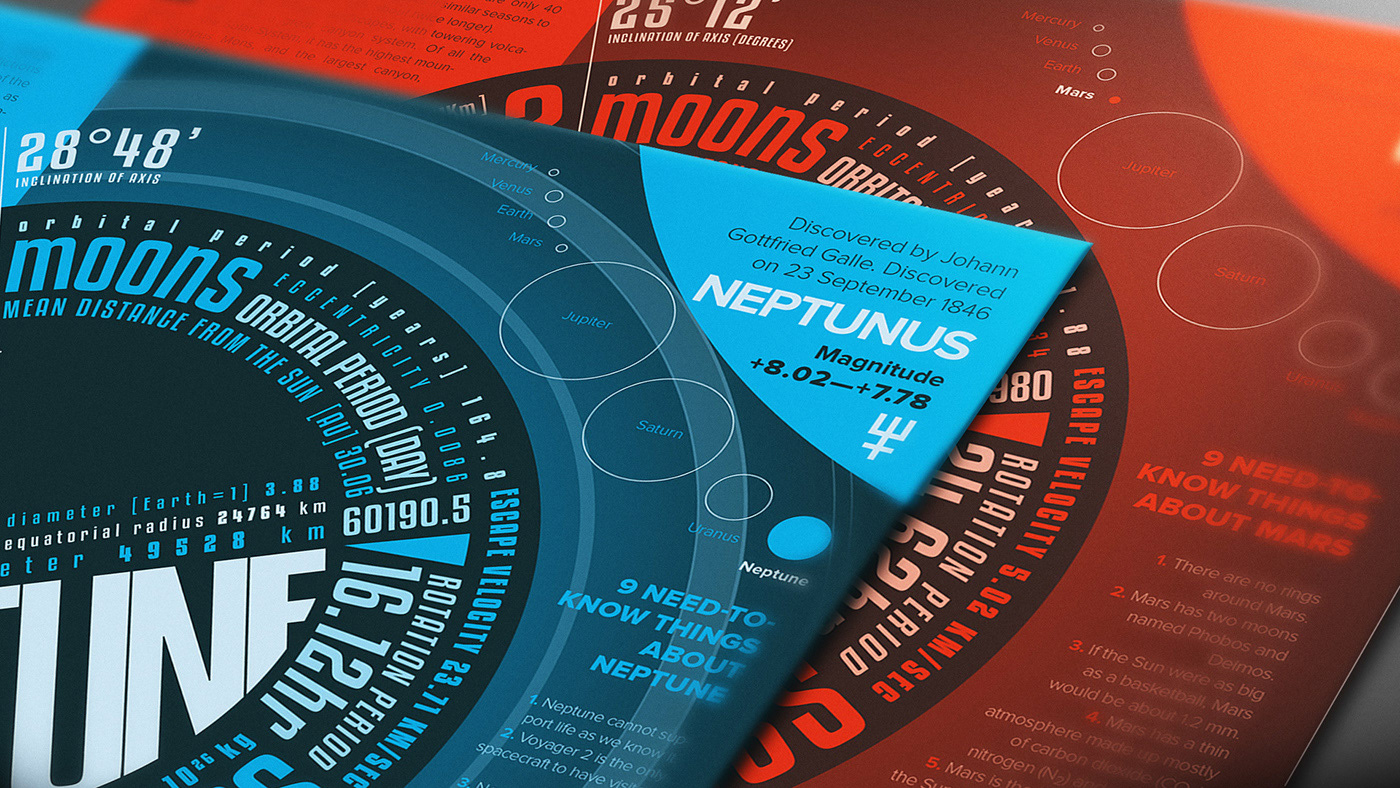Solar system infographic posters
Finally I redesigned my old Solar System posters. I kept the concept of arranging the planet's data in a ring like way and most of other infos, but I changed the tipography and the background. The original idea was to make a series of poster which contain all of the important informations about every single planet.

Sun
Did you know, the center of our solar system is an uncommon star? The axis of rotation is not perpendicular to the plane of the planets, it is tilted. The Sun also spins around itself and rotates around the galaxy center, the supermassive black hole. How much time does it take? Check it on your new poster!

Mercury
The hot planet…with ice. Mercury is the closest to the Sun and the smallest planet in the Solar system (no, unfortunately Pluto is still not considered to be a planet). The diameter is less than the Ganymedes, moon of Jupiter. Still, it has some atmosphere or is it exosphere instead? Are there any winds on Mercury? Find it out!

Venus
The pink planet! Well, not exactly. The color represents the mystical / mythical reference to the ‘’feminine” features of this planet. Although I can confirm, women are not form Venus. This planet remind astronomers of our own Earth and one of the potential alternative future of our planet. Greenhouse gases and other natural phenomena caused Venus to be a hot planet with no chance of human life on it and we can turn our planet into the same hellish conditions.

Earth
The Blue planet on a green poster. Yes, we intentionally picked the green as the representation of LIFE. The green vegetation of our planet is still unique in the solar system, the blue oceans are not anymore. We know, there is water on Mars (frozen) and on Europa (below some layers of ice). Also, the outer planets are even bluer, so green it is! Some may think, we already know everything about our planet, what can I learn from this poster? Well, I am pretty sure you may have some challenge to draw a picture of the magnetic field around the Earth or to remember the thickness of the solid, inner core of the Earth.

Moon
The brightest and largest object in our night sky. The Moon was the first place beyond Earth humans tried to reach as the Space Age began in late 1950s. Earth's only natural satellite is simply called "the Moon" because people didn't know other moons existed until Galileo Galilei discovered four moons orbiting Jupiter in 1610.

Mars
Mars is a popular planet. Even Matt Damon was there who "Scienced the sh*t out of it." We have rovers, probes even a permanent orbiter is revolving around the red planet. Mars is smaller than Earth but it revolving at almost the same speed. How many minutes longer is a day on Mars? How small are the two moons orbiting the planet? Can we see Mars with naked eye?

Jupiter
The planet giant has many moons. Do you know all of them? The thick clouds hide from the naked eyes of the observer, what can be on the surface of this planet. Or is there a solid surface at all? What would be the temperature and the other atmospheric conditions there? Would we all be flat like a pancake due to the high gravity? This mysterious giant looks like a small star, which did not grow big enough to start fusing hydrogen in the core. Could have Jupiter become a second star in our Solar system if it was bigger?

Saturn
The planet with a ring. Or rings. Or a system of rings, moons and lots of debris orbiting in a very thin layer, like a vinyl record. The rings are not stabile formations and they will not last forever. How old are they? How long will they last? What are they made of? The biggest moon of Saturn is Titan. The only other object in the solar system beyond Earth, which has a precipitation system. Although it is not water-based but methane /ethane falls from the skies, forms lakes and then evaporates into clouds.

Uranus & Neptune
We all know, there are two gas giants out there. Much smaller than Jupiter, much bigger than Earth. This is all we know in general, but why are these planets much more interesting, than the first thought? What is the difference between them? Which is bigger? Which is colder? Do they have a solid core?
Uranus is very different than all the other planets with the 97 degree tilted axis of rotation! The „other” gas planet was discovered with a mathematical prediction based on the non-ideal orbit of Uranus. “There must be something big out there!” said the guys about 180 years ago, and started to look for a specific region of the sky. No surprise, Neptune was there.



Thanks for watching!




